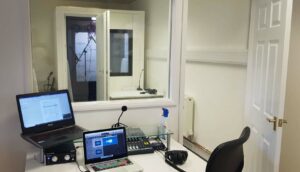6 Ways to Direct Remote Voice Over

Simon Luckhurst is a voice director, and the owner of voice over production company Voice Talent Online. Here he offers advice on achieving best results when you are not physically present at the recording session.
How to Record & Direct Voice Over Remotely
Working-from-home doesn’t stop you directing voice over recordings or damage the product of your sessions. In fact, it makes things easier!
We look at how the everywhere-use of meeting apps, and the huge number of home-based voice talent (filtered by a good voice over company), make this an industry no-brainer.
So, you (and/or your voice talent provider) have chosen a voice over resource with remote recording capabilities, and now you want to direct them…. What are your options?
1. Phone patch
Sometimes, the old ways can be best. If you want a low-latency recording experience where everyone has the technology, just pick up the phone, start the session and you’re away. Any good voice over agent can facilitate this, as well as ensuring the voice talent’s home studio is up-to-par (!) Wait a few minutes to receive the audio after the session – or a little longer while your post-production company performs its edits and magic. No dramas. Verdict: Universal and highly recommended.
2. Skype
Maybe you like the phone ‘thing’, but you’re out of signal, or perhaps you prefer a computer-based option? Skype is the next-simplest way forward. More or less everyone has it. Just Skype each other while the talent records and off you go. If you use an agent, and need creative/language assistance, a director or interpreter can also quickly be added to the session.
3. Microsoft Teams
As with Skype, a dead easy solution if you and/or the end-client have a Microsoft Office 365 account. The voice talent may not be equipped with MS Teams but your agent will be able to dial them into the meeting by phone. Just open a call and away we go.
4. ISDN
Wow! Back in the day, voice talents used this new-fangled thing called the “internet” to send full quality audio down a dedicated phone line. If you’re the kind of person who likes retro stuff – “land-lines”, fax machines and CD players – ISDN still actually works! (If you’re under the age of 20 you can find out what a “land-line” is here 😊). Verdict: Not recommended, since so few talents offer ISDN, you diminish your options too much.
5. Source Connect
Following the (relative) death of ISDN, Source Connect became an ‘industry’ method for studios to connect to one another. It does require quite a bit of technical know-how but as with ISDN, it enables you to record a remote session straight into your audio software (Pro Tools, Logic, Nuendo, etc.). But most directors AND most voice talent do not have this software. So it’s a double-edged sword (you get to preview the audio against your picture instantly, but your voice options are incredibly limited). For pure voice over, this option is much less-needed now that everyone (in a good professional network) records at studio quality and can connect by all the means mentioned above. But you may NEED to preview that voice to picture real-time…. Verdict: Contentious view but… if you don’t mind waiting a few minutes for your audio, and you use high-quality, agent-filtered voice talent, Source Connect is not recommended.
6. Zoom
That’s right! You can now record your voice over, face-to-face with the voice talent. Some voice talents now accept video calls over not only Zoom but also Skype, MS Teams and several other video conference platforms. Again, your audio is recorded locally (talent-side), but as long as the aforementioned agent-assisted filters are in place to ensure the quality, you’ll benefit from great, direct interaction. Verdict: Hmm, if you feel you need it, it’s ‘really cool’. But frankly, not recommended because you’re significantly cutting down your voice options.
Still struggling?
So what if the talent does not have the ability to provide any of the aforementioned options?
Fear not. There is still a great way to get your session done.
7. Don’t direct it!
Yes, this really is an option! Don’t need the hassle of a long-winded, directed session (how many takes?!) and technical hang-ups?
Now that voice talents record out of home studios (maybe use an agent to filter the quality!), you can preview a custom sample (from your script), give feedback and relax as you wait for the final recording. Watch as the whole process (casting, sample recording, approval, final session & delivery) takes a day or so – probably less time than it used to take to just book a traditional session! Verdict: For straight-forward jobs, this can work out fantastically well. But remember that for discerning clients, and/or if directorial needs are specific, this might not provide enough control.

–
And there you have it! Many ways to direct remote voice over.
Browse our network of high-quality voice talent now. Voice Talent Online will book your session, facilitate the connection of choice, and provide a director, interpreter and post-production as required. Experience the simple control you need now, with Voice Talent Online.
Comments
No comments yet